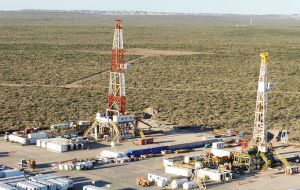MercoPress. South Atlantic News Agency
Soros signals Argentina’s shale is biggest place to be
 Soros’ move suggests he is not focusing on the short-term problems facing Argentina, but believes that the geological fundamentals are more important.
Soros’ move suggests he is not focusing on the short-term problems facing Argentina, but believes that the geological fundamentals are more important.  At the Neuquen basin YPF, in partnership with Chevron, is producing crude from the Vaca Muerta shale and is expecting to drill nearly 300 wells
At the Neuquen basin YPF, in partnership with Chevron, is producing crude from the Vaca Muerta shale and is expecting to drill nearly 300 wells One of the world’s legendary investors is upping his bet on Argentina’s shale oil and gas industry in a show of confidence for shale production in South America’s largest unconventional prize —and a big boost for both super-majors and smaller players making big waves in the heart of new discovery areas.
George Soros has doubled his stake in YPF SA, the state-owned oil company in Argentina, which sits atop some of the world’s largest shale oil and gas resources, and is about to get even larger following a new discovery over the last couple of weeks of a second key shale play.
Argentina holds an estimated 27 billion barrels of technically recoverable oil and 802 trillion cubic feet of technically recoverable shale gas, much of it located in the Vaca Muerta, an enormous shale formation in the Neuquén basin -- the second-largest shale gas deposit and the fourth-largest shale oil deposit in the world.
And on Aug. 14, YPF announced the discovery of oil in another shale formation—Agrio shale--in the same basin.
Some estimates suggest that combined, the two plays’ reserves could be worth as much as 3 trillion dollars.
“I am very excited with this [Agrio] discovery that proves that Vaca Muerta and Chubut’s D-129 formation aren’t the only shale deposits we have to exploit in Argentina,” YPF CEO Miguel Galuccio told reporters, according to Bloomberg. “The tests are very promising but still, it is too soon to provide figures.”
In the meantime, Soros’ confidence helps override some negative incidents that had held back investment in Argentina’s shale, including the government’s 2012 expropriation of YPF, then owned by Spanish firm Repsol, and the government’s failure to make a July 30 bond payment, which has resulted in a standoff with a hedge fund over unpaid bills back to the last default in 2001.
The government of Cristina Fernandez de Kirchner, however, has taken steps to repair Argentina’s relationship with international markets, and even tweaked tax laws in 2013 to give special benefits to big oil companies willing to invest more than 1 billion dollars in the country.
The move was immediately followed by Chevron’s announcement that it would enter into a joint venture with YPF. To incentivize the global energy industry to further invest, additional steps are being taken, including discussions for a new hydrocarbon bill that could further standardize and incentivize the industry for both super-majors and mid-sized companies.
The newest discovery is certainly vindication for Soros’ gamble on Argentina. His company, Soros Fund Management LLC, took a strong position in YPF in the second quarter of this year, doubling its position. It now controls 3.5% of YPF’s American depositary receipts, worth 450.5 million.
Soros’ move suggests that his firm is not focusing on the short-term problems facing Argentina, but believes that the geological fundamentals are more important. By increasing his stake in YPF, he is betting that Argentina is sitting on some lucrative plays that could be bigger than the Eagleford or Bakken in the United States.
According to the Financial Times, “Some of the world’s largest hedge funds have been snapping up Argentine stocks, betting on an economic recovery in the country even though it defaulted on its debt for the second time in 13 years.”
And while the market has caught on to the ‘Soros Factor,’ it hasn’t yet caught on to the smaller companies that are positioned to benefit from the Vaca Muerta shale and the new Agrio find.
The Neuquen basin is also where YPF, in partnership with Chevron, is producing crude from the Vaca Muerta shale and is expecting to have nearly 300 wells drilled in the Loma Campana/Loma La Lata area.
It’s great news for Chevron, but it’s also great news for smaller players with big footprints on this scene who will benefit from all the super-major drilling in the emerging Vaca Muerta and the new Agrio shale formations—as well as from the confidence boost provided by Soros.
There are only a few junior companies who have significant land holdings in Argentina’s Neuquen Basin, among them, Magdalena Energy Inc (MVN.V), which will benefit from Chevron’s plans to drill 300 wells just west of the junior’s Coiron Amargo block.
The point is that as the super-majors drill, the smaller companies reap the benefits, positioning themselves for big rewards with big players who are eyeing their large tracts of land in this promising basin.
“Given the size of the resource prize in both Vaca Muerta and Agrio, Argentina is home to one of the biggest unconventional plays in the world,” said Kevin Shaw, CEO of Madalena Energy, which controls around 1 million net acres in Argentina and plans to begin shale development in the Agrio formation later this year or in early 2015.
“Some of the largest oil companies around the globe are continuing to actively drill and appraise Argentina’s Vaca Muerta shale and are now starting to do work in the Agrio shale,” Shaw said.
For oil and gas explorers both big and small, Argentina is back--with possibly more shale than the United States, and the industry is more active than ever.
Like Warren Buffet, when George Soros makes a big move, people notice. Their decisions, which sometimes run counter to conventional wisdom, are often seen in hindsight as signals of trends that few investors are noticing.
By James Stafford of Oilprice.com




Top Comments
Disclaimer & comment rules-

-

-

Read all commentsSo these ones aren't the vulture funds?
Sep 03rd, 2014 - 10:27 pm 0Right?
”According to the Financial Times, “Some of the world’s largest hedge funds have been snapping up Argentine stocks, betting on an economic recovery in the country even though it defaulted on its debt for the second time in 13 years.”
Sep 03rd, 2014 - 10:48 pm 0Did Yankeeboy predicts this...????.......;-))))
....ermmm...nope....
The Merval is an interesting animal, it is one of the few ways that Rgs can get U$ equivalents. I think that's why its been going up. Not the hedge fund buying.
Sep 03rd, 2014 - 11:06 pm 0This is another sign of desperation to get some sort of savings in something worth anything.
Think about this, these Rgs are willing to invest in a volatile stock just to get their hands on some sort of U$.
It is sad.
I also think VM is a bust. If there was something substantial there somebody would be drilling. And only 16 active drills tells me there's nada.
Commenting for this story is now closed.
If you have a Facebook account, become a fan and comment on our Facebook Page!